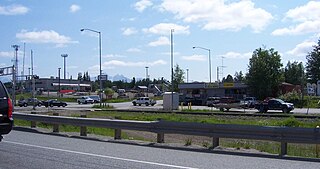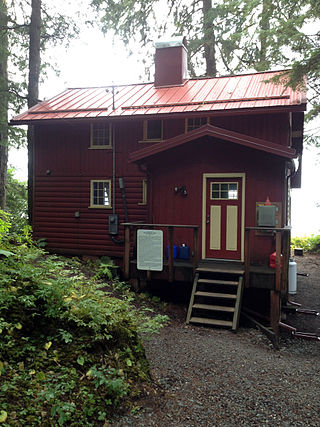
Klondike Gold Rush National Historical Park is a national historical park operated by the National Park Service that seeks to commemorate the Klondike Gold Rush of the late 1890s. Though the gold fields that were the ultimate goal of the stampeders lay in the Yukon Territory, the park comprises staging areas for the trek there and the routes leading in its direction. There are four units, including three in Municipality of Skagway Borough, Alaska and a fourth in the Pioneer Square National Historic District in Seattle, Washington.
Dorothy G. Page was best known as "Mother of the Iditarod Trail Sled Dog Race", the 1,049-mile dog sled race across the U.S. state of Alaska.

Piney Grove at Southall's Plantation is a property listed on the National Register of Historic Places in Holdcroft, Charles City County, Virginia. The scale and character of the collection of domestic architecture at this site recalls the vernacular architectural traditions of the eighteenth, nineteenth and twentieth centuries along the James River.
Knik may refer to the following entities in Alaska:

The Murie Ranch Historic District, also known as the STS Dude Ranch and Stella Woodbury Summer Home is an inholding in Grand Teton National Park near Moose, Wyoming. The district is chiefly significant for its association with the conservationists Olaus Murie, his wife Margaret (Mardy) Murie and scientist Adolph Murie and his wife Louise. Olaus and Adolph Murie were influential in the establishment of an ecological approach to wildlife management, while Mardy Murie was influential because of her huge conservation victories such as passing the Alaska National Interest Lands Conservation Act of 1980 and being awarded with the highest civilian honor, the Presidential Medal of Freedom, for her lifetime works in conservation. Olaus Murie was a prominent early field biologist in the U.S. Biological Survey and subsequent U.S. Fish and Wildlife Service before retiring and becoming the president of the Wilderness Society, He was a prominent advocate for the preservation of wild lands in America.

The Old Faithful Historic District in Yellowstone National Park comprises the built-up portion of the Upper Geyser Basin surrounding the Old Faithful Inn and Old Faithful Geyser. It includes the Old Faithful Inn, designed by Robert Reamer and is itself a National Historic Landmark, the upper and lower Hamilton's Stores, the Old Faithful Lodge, designed by Gilbert Stanley Underwood, the Old Faithful Snow Lodge, and a variety of supporting buildings. The Old Faithful Historic District itself lies on the 140-mile Grand Loop Road Historic District.

The City of Wasilla (Dena'ina: Benteh) is a city in Matanuska-Susitna Borough, United States and the fourth-largest city in Alaska. It is located on the northern point of Cook Inlet in the Matanuska-Susitna Valley of the southcentral part of the state. The city's population was 9,054 at the 2020 census, up from 7,831 in 2010. Wasilla is the largest city in the borough and a part of the Anchorage metropolitan area, which had an estimated population of 398,328 in 2020.

The Alaskan Engineering Commission (AEC) was a U.S. Federal agency, sometimes known by its initials or by alternate spelling Alaska Engineering Commission. It was created by the Alaska Railroad Act in 1914 by U.S. President Woodrow Wilson in order to arrange for the construction of a railway system in Alaska. William C. Edes was named chairman, chief engineer Colonel Frederick Mears. In 1915, the AEC became part of the U.S. Department of the Interior. In 1923, after the railroad began operation and construction was complete, it became the Alaska Railroad Commission, later renamed to The Alaska Railroad.

The Wasilla Depot was built in 1917 in Wasilla, Alaska. It was designed and built by the Alaska Engineering Commission, a federal agency charged with building Alaska's railways. The structure, located at the corner of Parks Highway and Main Street, was restored by the Lions Clubs and the Wasilla Chamber of Commerce.
The Whitney Section House, also known as Whitney Station, is a historic railroad-related building in Wasilla, Alaska. It is a single-story wood-frame structure, which was built in 1917 by the Alaska Railroad. It originally stood at mile 119.1, about 4.8 miles (7.7 km) north of Anchorage Station, and was one of a series built by the railroad and located at roughly ten-mile intervals. The area where it stood was taken by the federal government for Elmendorf Air Force Base, and was rescued from demolition by the local chapter of the National Railroad Historical Society. It now stands on the grounds of the Alaska Museum of Transportation and Industry in Wasilla, and has seen a variety of uses.

The Russian Bishop's House, once the Russian Mission Orphanage, is a historic house museum and National Historic Landmark at Lincoln and Monastery Streets in Sitka, Alaska. Built in 1841–43, this log structure is one of the oldest surviving buildings of Russian America, and was one of the centerpieces of the Russian Orthodox church's efforts to spread its influence among the natives of Alaska. It was the home and administrative center of Ivan Veniaminov, the first Bishop of Alaska, later canonized as Innocent of Alaska. The house is now a unit of Sitka National Historical Park, and is administered by the National Park Service.
The St. Nicholas Russian Orthodox Church is a historic Russian Orthodox church near Kwethluk, Alaska, United States, on the Lower Kuskokwim River. In 2017 it is part of the Diocese of Alaska of the Orthodox Church in America

The Ernest Gruening Cabin is a historic rural cabin in Juneau, Alaska, United States, and the centerpiece of Ernest Gruening State Historical Park. It is a 1+1⁄2-story wood-frame structure located 26 miles (42 km) north of the city on the Glacier Highway. It is the only building associated with the life of Ernest Gruening, governor of the Alaska Territory 1939–53, other than the Alaska Governor's Mansion. The cabin was built on land Gruening leased from the United States Forest Service, and was built by local laborers including Gruening's son Hunt. The cabin measures 24 feet (7.3 m) by 28 feet (8.5 m), with a gable roof and a large fieldstone chimney. Its exterior is finished in shiplap siding milled to resemble unfinished logs. The interior consists of a single large chamber, with a circular stairway leading to a sleeping loft above. The kitchen area is set apart from the rest of the space by different flooring, an alteration by Gruening's grandson. The property is now a state historic site.
The Wasilla Community Hall, also known as the Wasilla Museum, now hosting the Dorothy G. Page Museum, is located at 323 Main Street in Wasilla, Alaska. The museum is located in a log building constructed in 1931 to serve as a community center. The exterior of the building was left largely as-is when it was converted to a museum in 1967. The interior houses displays about the history of the city of Wasilla.

The Oscar Gill House is a historic house at 1344 West Tenth Avenue in the South Addition neighborhood of Anchorage, Alaska. It is one of Anchorage's oldest buildings. It is a two-story wood-frame structure, three bays wide, with a side gable roof. The bays are asymmetrically arranged, with a single-window bay on the right and a double-window bay on the left. The center bay is taken up by a projecting gable-roofed vestibule, in which the door is slightly off-center. The house's modest Craftsman style includes extended eaves with exposed rafter ends, and it has retained original interior flooring and woodwork. The house was built in 1913 by Oscar Gill in the town of Knik at the head of Knik Arm. When Anchorage was established in 1916, Gill had the house barged across the inlet, and it stood at 918 West Tenth Avenue for many decades. The house was removed from that site in 1982 to accommodate expansion of the Anchorage Pioneer Home, one of many historic houses throughout downtown Anchorage which fell victim to a real estate and building boom that intensified in 1982 and 1983. Unlike other similar structures, most of which spent years in storage on municipally-owned land but were eventually demolished, this house was spared. It sat on a vacant lot on P Street, across from the western end of the Delaney Park Strip, for approximately a decade and a half before being moved to its present location. The house has been operated as a bed and breakfast establishment since that time.

The Knik Site, also known as the Old Knik Townsite, is the location in Matanuska-Susitna Borough, Alaska that was once home to the largest settlement on Cook Inlet. The only surviving remnants of the community are a former log roadhouse, now a museum operated by the Wasilla-Knik Historical Society, and a log cabin. The Knik area had long been a meeting point of Native Alaskans, and in 1898 it became the principal community on Cook Inlet from which goods were shipped into the interior. In 1916 the Alaska Railroad reached the site of present-day Anchorage, bypassing Knik and leading to Anchorage's growth. When the railroad reached Wasilla, Knik lost all importance as a transshipment point, and its buildings were either abandoned or moved to one of the other communities. Knik is located about 13 miles (21 km) southwest of Wasilla.
The Blanche and Oscar Tryck House is a historic house on North Knik Street in Wasilla, Alaska. Built sometime before 1916 at Knik, it was the first house in Wasilla when the community was established, moved there by the Trycks in 1917. It is a single-story wood-frame structure, roughly rectangular in shape, with a concrete foundation and a corrugated metal gable roof configured to capture rainwater for laundry and other uses. It has a brick chimney and a root cellar, and has been vacant since Oscar Tryck died in 1964.

The Guilford Country Store is located at 475 Coolidge Highway in Guilford, Vermont, in the 1817 Broad Brook House, one of the oldest surviving tavern houses in the state, which has been in continuous use as a general store since 1936. The building was listed on the National Register of Historic Places in 2011.

The Watrous General Store, also known as the Juniata Township Hall, is a former commercial structure located at 4607 W. Caro Road in Watrousville, Michigan. It was listed on the National Register of Historic Places in 1974. It currently houses the Watrousville Museum.

















